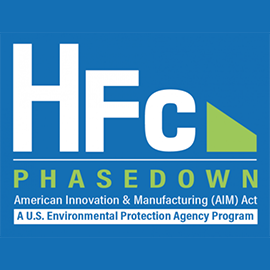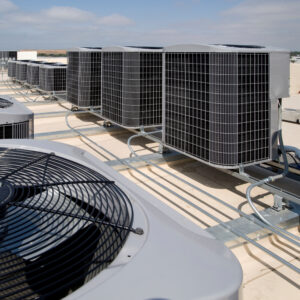
The Future of Refrigerants: Understanding the DOEs Efforts to Meet White House Climate Change Goals
Based on the lessons learned from the industry transition from HFCs to A2Ls, the U.S. Department of Energy (DOE) has taken steps to fast track the determination of how to make the transition to more environmentally friendly refrigerants.
The driving forces behind the HVAC industry’s transition to A2L refrigerants are the HFC Phasedown Program and the Technology Transitions Program. Both initiatives were implemented by the U.S. Environmental Protection Agency (EPA) under the authority of the American Innovation and Manufacturing Act of 2020 (AIM Act) to manage the phasedown of HFC refrigerants. These programs were enacted to enable the U.S. to lower greenhouse gas emissions 50 to 52 percent below 2005 levels by the year 2030.

Looking beyond 2030, the White House has set an ambitious goal of net-zero greenhouse gas emissions by no later than 2050. To attain this goal, more changes will be required within the HVAC industry. First and foremost, is moving from A2L refrigerants to A3 refrigerants where feasible. A3 refrigerants are a class of refrigerants that are non-toxic with high flammability. This class includes refrigerants such as propane that are more environmentally friendly than A2Ls. They have little to no ozone depleting potential and little to no global warming potential.
Based on the lessons learned from the industry transition from HFCs to A2Ls, the U.S. Department of Energy (DOE) has taken steps to fast track the determination of how to make the transition to these environmentally friendly refrigerants. The DOE understands that making major refrigerant changes require:
- Regulations to be updated
- Codes and standards must be updated
- Manufacturing lines to be retooled
As we learned during the phasedown of HFCs, these processes can take a decade or more to complete. To align with the White House’s 2050 climate goals, the DOE has adopted a different approach.
Future of Refrigerants for Building HVAC Applications Workshop

The DOE Building Technologies Office and Oak Ridge National Laboratory (ORNL) hosted an industry workshop from April 1-2, 2024, titled Future of Refrigerants for Building HVAC Applications. The in-person workshop brought together leaders across the U.S. and global HVAC&R sector to better understand and collaborate on the path forward for ultra-low GWP refrigerants for building space conditioning applications.
The workshop focused on brainstorming new ultra-low GWP refrigerant technologies that currently exist globally or can easily be commercialized for quick entry to the U.S. market. The goal was to identify “feasible” technologies that will enable the U.S. to meet the administration’s 2050 climate targets.
The workshop provided insights from manufacturers, large purchasers of HVAC&R equipment, states, non-government organizations (NGOs) and codes and standards bodies on building HVAC topics. During this inaugural workshop, participants received insights on:
- The Biden White House priorities
- The latest international technologies and refrigerant options
- Concerns of large purchasers of HVAC&R equipment (i.e. GSA, Target, and Walmart)
- Overview of the process of implementing changes to codes and standards
- Ongoing state efforts impacting refrigerants (CA, NY, and U.S. Climate Alliance states)
- Industry challenges for manufacturers (i.e. Carrier, Trane, and Johnson Controls)
A key takeaway from the workshop was the potential to introduce technologies or products from other parts of the world to the U.S. market. However, this would require adjustments to U.S. regulations, codes, and standards.
Working Group Activities
As a result of this workshop, the DOE formed two working groups to address follow-up activities. The first workgroup is focused on research and development initiatives required for A3 refrigerants and the second is focused on codes and standards actions that would be required to move forward with adoption of new A3 refrigerant technologies.
The DOE desires to garner stakeholder support for early, voluntary market introduction of ultra-low GWP refrigerants – regulatory efforts are outside of the scope for this work. The goal is for the working groups to focus on product areas with lower entry barriers and broader market applicability, offering the best chance of progressing through the codes and standards processes.
The objective of each workgroup was identified as follows:
Research and Development:
The research and development (R&D) working group will identify the foundational R&D activities required to enable us to begin to open the market to ultra-low GWP A3 refrigerants in building HVAC applications. This group will work from a draft analysis methodology that Oak Ridge National Laboratory will develop and vet with stakeholders. The R&D workgroup will enable relevant parties to coordinate and expedite R&D efforts and identify any remaining gaps in the research.
Codes and Standards:
The codes and standards working group will identify the changes that are needed to enable the broader use of ultra-low GWP A3 refrigerants. This group will work from a process map that the DOE will draft and vet with stakeholders. The process map will capture all steps and major players with the aim of condensing the codes and standards timelines. The workgroup will enable stakeholders to join forces on updating codes and standards. Code Council members and staff are members of this working group and have been collaborating on how best to integrate required changes into the code development process.
Aligned with the goal of targeting product areas with lower entry barriers and broader market applicability, the working group will prioritize three key areas: commercial indirect A3 systems, residential indirect A3 systems, and direct, small-charge, self-contained A3 systems.
As such, the codes and standards working group created three subgroups:
- Subgroup 1: Commercial Indirect A3 Systems
- Subgroup 2: Residential Indirect A3 Systems
- Subgroup 3: Direct, Small Charge, Self Contained A3 Systems
Each subgroup was tasked with reviewing current risk assessment literature and proposing research activities that would be required to garner stakeholder support to move forward with that particular technology.
Subgroup Activity
The subgroups met on multiple occasions beginning in July 2024 to complete their work. They investigated what would be required for the safe use of A3 refrigerants; reviewed previous projects relevant to the research activities and identified supplementary activities that could be addressed quickly, or those that would occur after the primary research activities; and determined potential codes and standards updates that would be required.
Further, with respect to research activities, their goal was identifying the following:
- Specific activities to be conducted
- Organizations to perform the activities
- Potential sponsors or sources of funding
- Additional resources needed (e.g., equipment, facilities)
- Estimated timeline
- Risks to be considered (10+ risks listed)
At this time, preliminary reports have been drafted, but further work continues for each of the subgroups. Upon completion, the DOE will take some time for thoughtful consideration and planning of the next steps to chart the path forward for R&D activities and future needs.
To stay updated on PMG-related news, subscribe to the Code Council’s PMG newsletter here.








